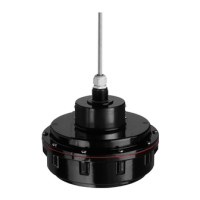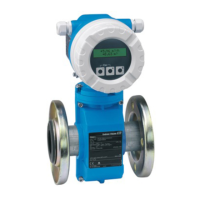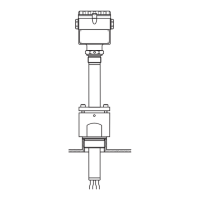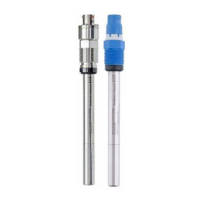Deltabar S
Endress+Hauser 47
Influence of the temperature on
the zero point for diaphragm
seal systems
A temperature change results in a volume change of the filling oil. The volume change is dependent on the
coefficient of thermal expansion of the filling oil and on the volume of the filling oil at calibration temperature
(+77°F/+25°C , range: +69.8 to 91.4°F/+21 to +33°C). → See also page 46, section "Diaphragm seal filling
oils".
For example, the filling oil expands in the event of a temperature increase. The additional volume presses
against the diaphragm seal membrane. The stiffer a diaphragm is, the greater its return force, which counteracts
a volume change and acts on the measuring cell together with the operating pressure, thus shifting the zero
point. For the "T
K
Process", see page 37 ff, section "Process connections FMD 78".
The following diagrams display the temperature coefficient "T
K
Ambient" dependent on the capillary length.
The following application is displayed: capillary temperature and transmitter temperature (ambient
temperature) change, the process temperature corresponds to the calibration temperature.
The temperature coefficients obtained from the diagrams apply to silicone oil and the membrane material AISI
316L. For other filling oils, these temperature coefficients must be multiplied by the T
K
correction factor of the
corresponding filling oil. For the T
K
correction factors, see page 46, section "Diaphragm seal filling oils".
P01-FMD78xxx-05-xx-xx-xx-001
Example for:
– Diaphragm seal versions "B5, EN/DIN Flange DN 80 PN 10-40 B1, AISI 316L"
– Capillary length: 16 ft (5 m)
– Ambient temperature, capillary/transmitter: 113°F (45°C)
– Filling oil: silicone oil
1. Select characteristic curve type for the diaphragm seal versions "B5" in accordance with the following
table.
Result: characteristic curve type 2
2. Obtain value for T
K
Ambient from the diagram.
Result: 1.4 mbar/10 K
3. T
ambient
– T
calibration
= 45°C – 25°C = 20°C ⇒ 1.4 mbar/10 K • 20 K = 2.8 mbar
Result: In this application, the zero point is shifted by 2.8 mbar.
Note!
The influence of temperature on the zero point can be corrected with position calibration.
1
2
3
4
5
6
8
7
1.4
mbar
10 K
4
0
2
6
10
8
12
012345678910
[m]
Capillary length
[mbar/10 K]
T Ambient
K

